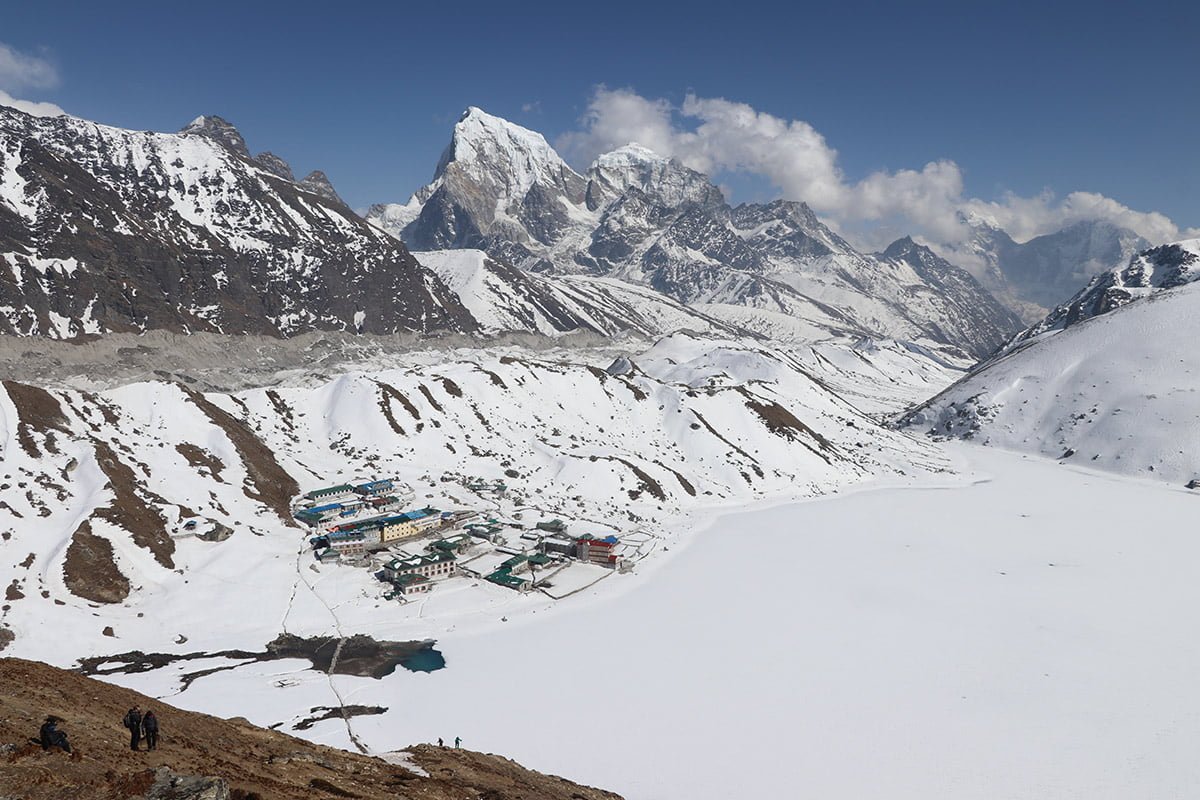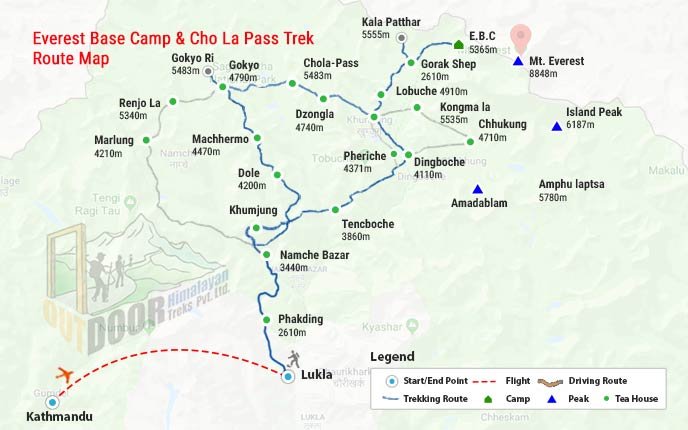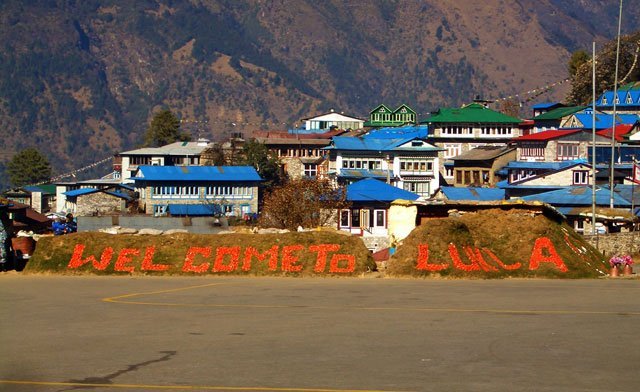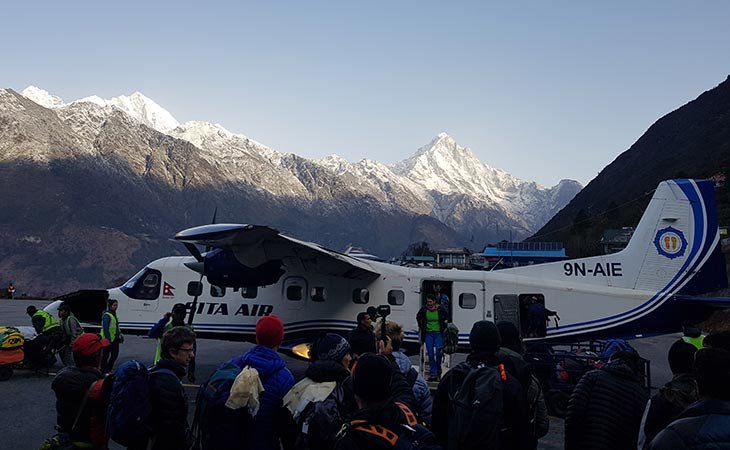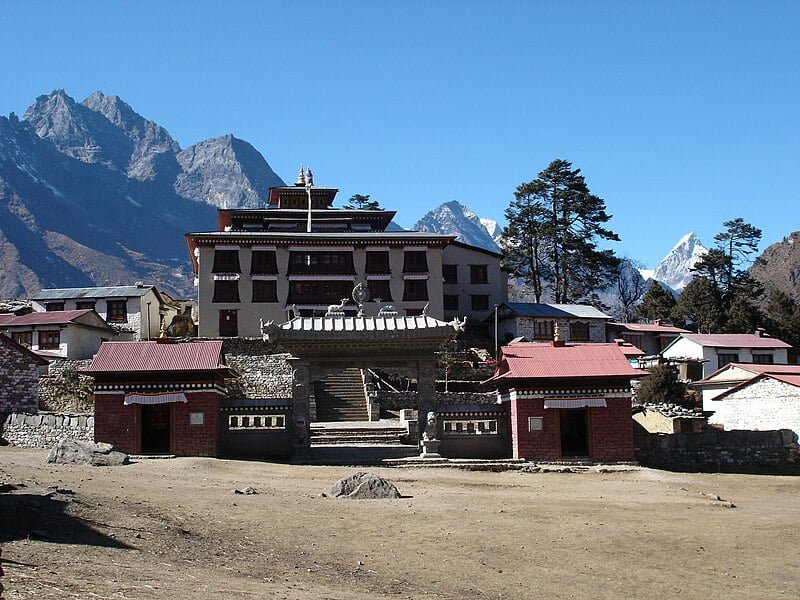Everest Base Camp via Cho La Pass trek is a full-fledged adventure trek over the challenging terrains of the Himalayas of Nepal in the vicinity of Mt. Everest. The trek combines most of the spectacular vantage points falling in the Everest region.
Is this Everest Base Camp via Cho La Pass for me?
Physical Grading: Difficult
A difficult-graded trek that demands trekkers/travelers to have a top level of physical and mental fitness to trek daily for long hours at high altitudes.
Max Elevation: 5,644.5 m (Kalapatthar)
The highest point of the trek is a perfect vantage point to get close-up views of Everest, Pumori, Ama Dablam, etc.
Accommodation: Hotel, Teahouse
Comfortable accommodation with basic facilities during the trek and a standard hotel in a city.
Meals: Full Board
Healthy and Hygienic 3-course gourmet meals during the trek, and only breakfast in a city.
Best Season: Autumn & Spring
Stable weather and temperature offer clear views and comfortable trekking trails.
Trip Route:
Kathmandu to Lukla flight - Trek to Phakding - Namche Bazaar – Tengboche – Dingboche – Lobuche – Gorakshep - Everest Base Camp – Gorakshep – Kalapatthar – Lobuche – Dzongla - Cho La Pass – Thagnak -Gokyo - Gokyo Ri – Dole - Namche Bazaar – Lukla - Kathmandu flight
Everest Base Camp via Cho La Pass Highlights
- Traverse the High Pass Cho La (5,420 m)
- Everest Base Camp (5,364 m) and Kalapatthar viewpoint (5644.5 m)
- Massive Ngozumpa Glacier
- An incredible panoramic view of the Khumbu Himalayas
- Mesmerizing Gokyo Lake and superb Gokyo Ri
- Attractive Khumjung village and other Sherpa settlements
- Impressive views of Everest, Makalu, Cho-Oyu, Gychung Kang
- Sherpa locals, lifestyle, and culture
Flight Information
Everest Base Camp is every enthusiastic trekker’s dream destination. So, usually during the peak trek seasons, the inflow of trekkers is higher. So, the air traffic in Kathmandu during the months of April, May, October, and November is tough to manage. Therefore, the flight schedules to Lukla are operated from Ramechhap which is a 4-hour drive from Kathmandu.Everest Base Camp via Cho La Pass Overview
Everest Base Camp via Cho La Pass trek is a full-fledged adventure trek over the challenging terrains of the Himalayas of Nepal in the vicinity of Mt Everest. The trek combines most of the spectacular vantage points falling in the Everest region. After we reach Namche Bazaar, we move on to Tengboche, Dingboche, Lobuche, Gorakshep, and Kalapatthar. Then we backtrack a little to Lobuche and head on to Dzongla; from where we cross the formidable Cho La Pass to reach Gokyo on the other side. Then climb Gokyo Ri and return to Namche via Dole. Although you do not climb Everest during this trip, you will perfectly find out where Mt. Everest is, and how it looks; having observed it from different angles and having known its surroundings in detail.
Everest Base Camp via Cho La Pass is certainly a difficult trek, but you should know that even the easiest of the treks in the Everest region gives you a tinge of adventure with high-altitude hikes as well as steep walks up and down. Despite its difficulties, the rewards of this trek stand high over its hazards; thus inspiring the ever-larger number of intrepid trekkers to face the challenges head-on.
Not only do they enjoy awesome mountains and their incredible panorama from every stopover; but they do test all fiction and facts about Mt. Everest and the Everest region first-hand. They also get a chance to familiarize themselves with the Sherpas and their ways of life. As you take the trek, you will follow the famous “Everest Trail” trek to the prosperous village of Namche Bazaar and onwards; and also trek alongside the torrential Imja Tse River to the high valley below Mt. Everest. Embark on this trip with a brave heart; you will certainly get a boost to your morale.
Besides, you will set your definition and measurement of the most beautiful sceneries of the earth. Take pictures of Mt. Everest and other beautiful mountains and peaks and see how they look when you reach home! All in all, this trek distills most of the attractions and most of the challenges attending to any of your venturesome forage into the Everest Region.
